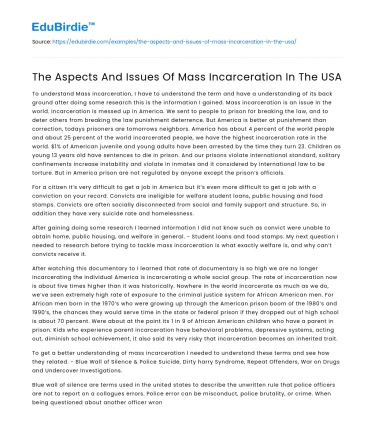Introduction
Mass incarceration in the United States represents a complex tapestry of legal, social, and economic challenges that have evolved over decades. The U.S. incarcerates more individuals per capita than any other country, a stark figure that underscores the profound implications of its criminal justice policies. This phenomenon is not merely a consequence of increased criminal activity but is deeply intertwined with systemic issues such as racial disparity, socioeconomic inequality, and legislative measures. As we delve into this topic, it becomes imperative to explore the various facets that contribute to mass incarceration, including the policies that have perpetuated this practice and the societal and individual impacts. The labyrinth of challenges associated with mass incarceration calls for a comprehensive analysis to unravel the intricacies of this pressing issue.
Historical Context and Legislative Influence
The roots of mass incarceration in the United States can be traced back to policy decisions made in the late 20th century. The "War on Drugs" initiated in the 1980s under President Ronald Reagan marked a pivotal shift towards harsher sentencing laws. Mandatory minimum sentences and the "three-strikes" laws significantly increased the prison population. Michelle Alexander, in her seminal work "The New Jim Crow," describes how these laws disproportionately affected African American communities, leading to what she terms "a racial caste system" (Alexander, 2010). These legislative measures were often justified under the guise of reducing crime but failed to address the underlying social issues contributing to criminal behavior, such as poverty and lack of education.
Save your time!
We can take care of your essay
- Proper editing and formatting
- Free revision, title page, and bibliography
- Flexible prices and money-back guarantee
The 1994 Crime Bill, signed by President Bill Clinton, further exacerbated the situation by incentivizing states to build more prisons. This legislation contributed to an incarceration boom, as it provided funding for state prisons and promoted policies like "truth in sentencing," which required inmates to serve the majority of their sentences without parole. Critics argue that these policies did little to deter crime and instead contributed to the ballooning prison population, which has had lasting effects on American society. According to the Bureau of Justice Statistics, the U.S. prison population peaked in 2009 at approximately 2.3 million individuals, a testament to the enduring impact of these laws.
Social and Economic Implications
The social ramifications of mass incarceration extend beyond the individuals who are incarcerated, deeply affecting families and communities. Incarceration disrupts family structures, with children of incarcerated parents facing increased risks of poverty, psychological issues, and academic challenges. The Pew Charitable Trusts highlight that one in nine African American children has an incarcerated parent, illustrating the racial disparities that permeate the system (Pew Charitable Trusts, 2010). This cycle of disadvantage perpetuates systemic inequality, as the children of incarcerated parents often encounter barriers to education and employment, hindering their social mobility.
Economically, mass incarceration places a significant burden on state and federal budgets. The cost of maintaining the U.S. prison system is estimated to exceed $80 billion annually, funds that could potentially be redirected towards education, healthcare, and community development. Moreover, formerly incarcerated individuals face numerous barriers to reintegration, including limited job prospects and housing discrimination, which can lead to recidivism. The National Institute of Justice reports a recidivism rate of 76.6% within five years of release, suggesting that the system fails to rehabilitate and support reintegration effectively.
Reform Efforts and Counterarguments
In recent years, there has been a growing movement towards criminal justice reform aimed at reducing mass incarceration. Legislative measures such as the First Step Act, signed into law in 2018, represent a shift towards more rehabilitative approaches. The Act focuses on reducing mandatory minimum sentences for non-violent offenses and promoting rehabilitation programs. Proponents argue that these reforms are essential steps toward addressing the over-reliance on incarceration as a solution to crime.
However, critics of reform efforts caution against overly lenient policies, arguing that they could lead to increased crime rates. They emphasize the need for a balanced approach that ensures public safety while addressing the root causes of criminal behavior. The challenge lies in finding a compromise that acknowledges the legitimate concerns of both sides. The Vera Institute of Justice advocates for evidence-based approaches, emphasizing that effective reform requires not only changes in legislation but also shifts in public perception and societal attitudes towards crime and punishment.
Conclusion
Mass incarceration in the United States is a multifaceted issue, deeply rooted in historical, social, and economic contexts. While legislative measures have contributed to the current state of mass incarceration, they alone cannot account for the systemic inequalities that persist. Addressing this issue requires a comprehensive approach that includes criminal justice reform, social welfare improvements, and economic investment in marginalized communities. As the nation grapples with the legacy of its incarceration policies, it is imperative to pursue solutions that not only reduce prison populations but also foster a more equitable and just society. The path forward involves challenging entrenched systems and working towards a future where justice is truly rehabilitative and restorative.






 Stuck on your essay?
Stuck on your essay?

